USB ports are an essential part of any computer system, allowing you to connect various devices like external hard drives, keyboards, mice, and more. However, there may be times when your USB ports stop working, leaving you unable to connect any USB devices. This can be particularly frustrating, especially when transferring files or using specific peripherals.
Many Windows 10 and Windows 11 users have reported similar issues where USB ports fail to recognize any devices. The root cause of this problem could range from hardware malfunctions, outdated drivers, or even incorrect power settings.
The good news is that, in most cases, this issue can be resolved with a few simple steps. In this guide, we will walk you through the essential troubleshooting steps to help you identify and fix the problem. So, if you’re tired of dealing with USB port issues, keep reading to discover how to get your USB ports working again in no time!
What Causes USB Ports to Stop Working in Windows 10/11?
USB ports are an essential component of any Windows 10 or Windows 11 computer, allowing you to connect a variety of devices. Before diving into troubleshooting steps, it’s important to understand the common causes behind USB port issues. Below are some of the most frequent reasons why USB ports may stop working:
- Debris in the Ports – Dust and other debris can accumulate in your USB ports over time, obstructing the connection between the port and your USB device, leading to connectivity issues.
- USB Device Issues – If your USB device isn’t working, the issue could be with the device itself, such as a damaged cable or connector. Try using a different USB device or cable to determine if the problem lies with the device.
- Outdated Windows Updates – Outdated Windows updates or missing updates can cause bugs or driver issues, resulting in USB port malfunctions. Make sure your system is fully updated to avoid these problems.
- USB Driver Problems – Your USB drivers may be outdated, corrupt, or even missing, which can interfere with USB port functionality. Updating or reinstalling your drivers can often resolve this issue.
- Power Settings – Some power-saving settings may cause specific devices or ports to turn off automatically to conserve battery life. Disabling these settings can often restore the USB ports to normal operation.
- Corrupt System Files – Corrupt or damaged system files can disrupt the normal functioning of USB ports, preventing them from working correctly.
Now that you’re aware of the common causes behind USB port failures, let’s move on to the troubleshooting steps to help you fix these issues and restore USB functionality.
Fixed: USB Ports Not Working in Windows 10/11
If you’re dealing with USB port issues in Windows 10 or Windows 11, here are some solutions to help you resolve the problem and get your USB ports working again:
1. Check and Clean Your USB Ports
Start by checking your USB ports for debris or other obstructions. Dust and other particles can accumulate in your USB ports over time, preventing a stable connection between the USB port and your USB device, causing connectivity issues.
- Clean your ports with a soft cloth or compressed air to remove any dirt or dust.
- Once cleaned, try connecting your USB device again to see if it functions properly.
- Test with a different USB device to rule out the possibility of a hardware issue with your USB device.
2. Inspect Your USB Hardware
If your USB device isn’t working, the issue could be with the device itself. Follow these steps to inspect your USB hardware:
- Check your cables – Ensure your device’s USB cables are securely connected. If loose, replace them with new ones.
- Inspect connectors – If your USB device has connectors, verify that they are properly inserted and free from damage or wear.
- Ensure compatibility – Not all USB devices are compatible with every USB port. Check your device’s specifications to ensure it’s compatible with the port you’re using.
If the issue persists, try using a different USB device or cable to help isolate the problem.
3. Restart Your Computer
Restarting your computer can often resolve minor issues affecting your USB ports. It’s a simple yet effective solution that can clear up temporary glitches or system conflicts.
Follow these steps to restart your computer:
- Click on the Start menu in your taskbar, or press the Windows button on your keyboard.
- Click on the Power button and select Restart from the available options.
- If there are any open apps preventing the restart, select Restart anyway, or manually close all open apps after saving any unsaved progress or files.
- Once your system reboots, check if your USB ports are now working.
If the issue persists after restarting, move on to the next solution.
4. Update Windows
An outdated operating system can lead to USB port issues, as newer updates often fix bugs and software conflicts that may be causing problems. Updating your Windows can resolve any issues with USB ports that are caused by software bugs or outdated drivers.
How to Update Windows 10:
- Click the Windows icon in the bottom-left corner of your screen to open the Start menu. Alternatively, use the Windows + I shortcut to open Settings.
- Navigate to Update & Security > Windows Update.
- Click on the Check for updates button and wait for Windows to find available updates.
- If updates are found, click on the View all optional updates link to see and install them.
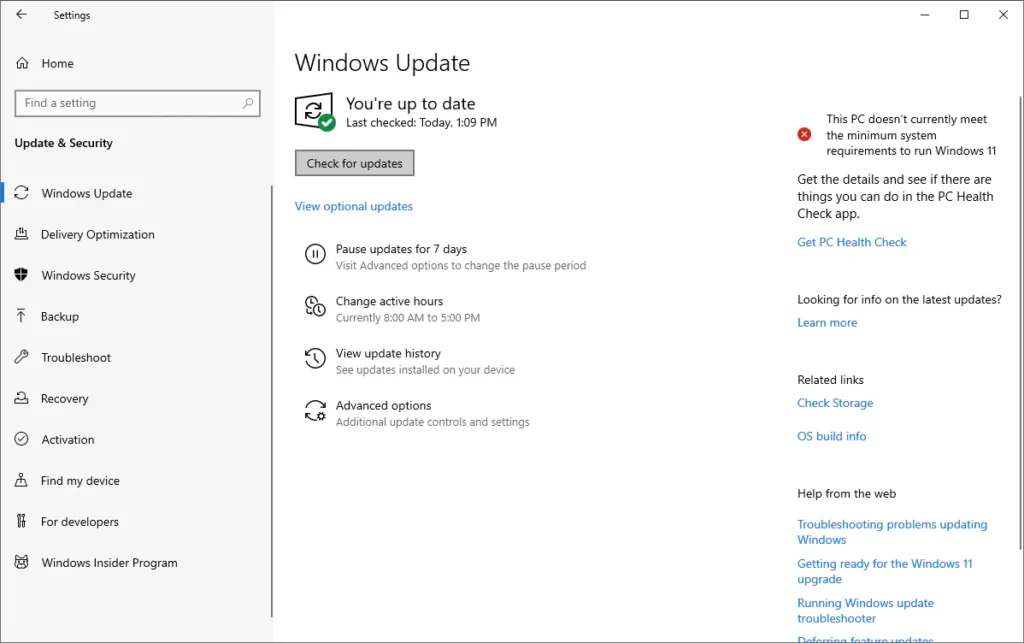
- Once Windows finds a new update, it will automatically begin installing. Allow it to download and apply the updates.
How to Update Windows 11:
- Click the Windows icon in the bottom-left corner to open the Start menu, and then select Settings (or use Windows + I).
- Switch to the Windows Update tab in the left-hand menu and click on the Check for updates button.
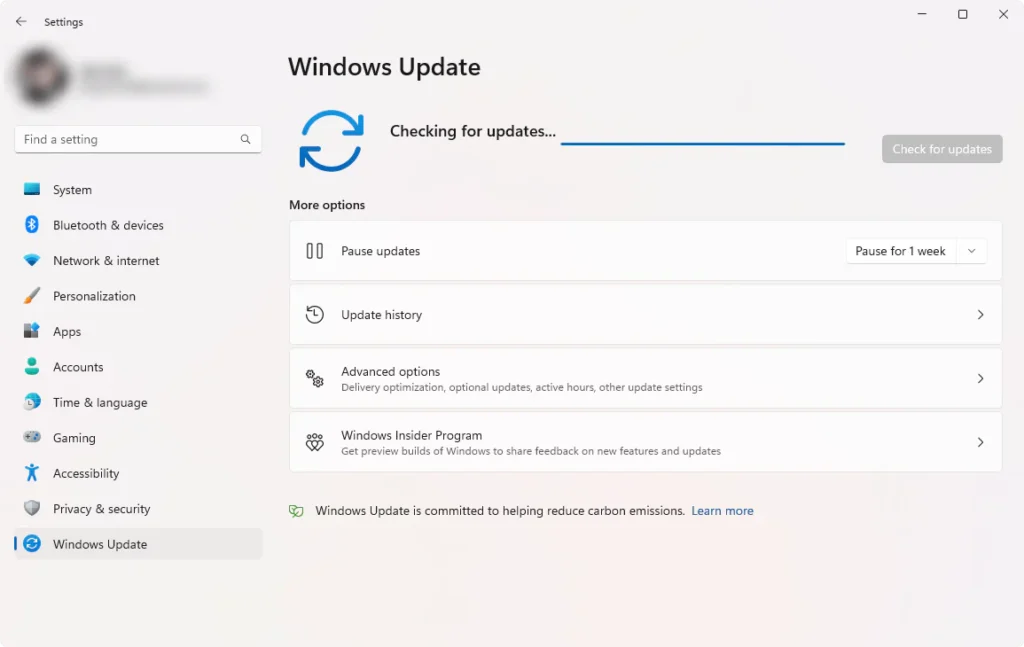
- If a new update is available, allow Windows to install it and follow the instructions to restart your computer.
Once the updates are installed, check to see if the USB ports are functioning correctly.
5. Reinstall Your USB Drivers
Corrupt or outdated USB drivers can cause issues with the USB port functionality. Reinstalling the drivers can help resolve the problem and get your USB ports working properly.
Steps to Reinstall USB Drivers:
- Press the Windows + X keys on your keyboard to open the Power User Menu, and then select Device Manager from the list.
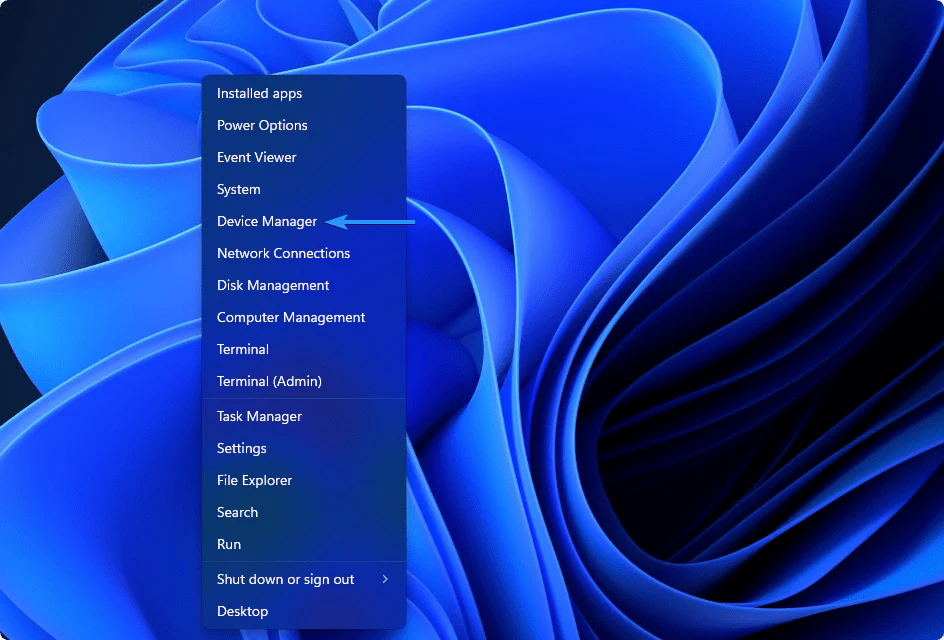
- In Device Manager, expand the Universal Serial Bus controllers category.
- Right-click on the first device listed under this category and select Uninstall device from the context menu.
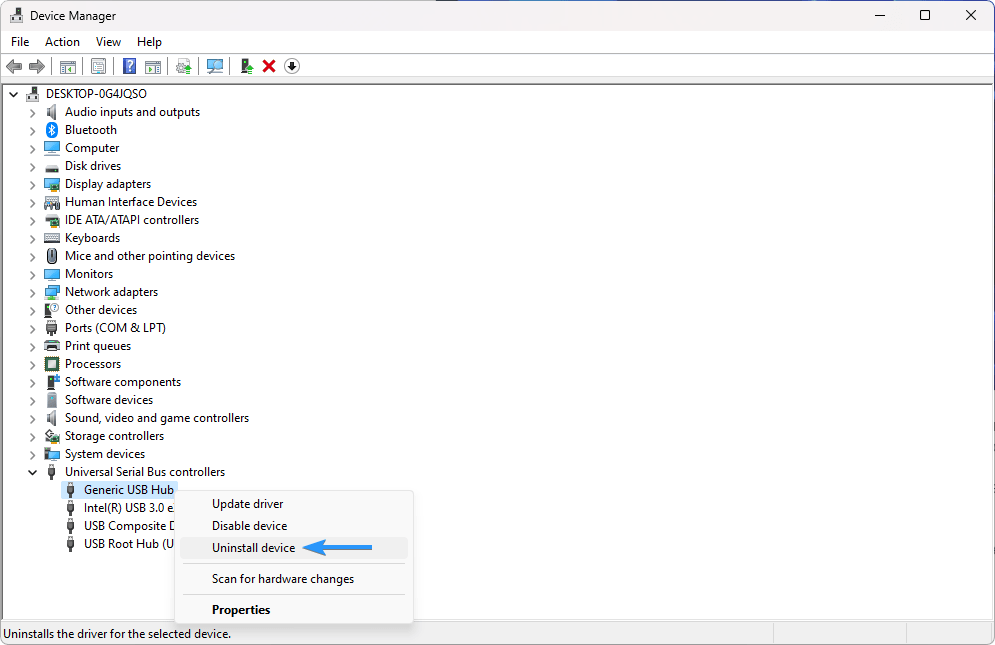
- Repeat the process for each device listed under the Universal Serial Bus controllers category. This will remove all the USB drivers from your system.
- Reboot your system. After the restart, Windows will automatically reinstall the necessary drivers for your USB ports.
After your computer restarts and installs the drivers, check if the USB ports are now functioning correctly.
6. Change Your Power Management Settings
Power-saving settings that automatically turn off specific ports or devices to conserve battery life can cause issues with USB ports. Disabling these settings for USB devices can help resolve connectivity problems.
Steps to Change Power Management Settings:
- Press the Windows + X keys on your keyboard and select Device Manager from the context menu.
- Expand the Universal Serial Bus controllers category by clicking the arrow next to it.
- Right-click on the USB Root Hub (or Generic USB Hub) device, and select Properties from the menu.
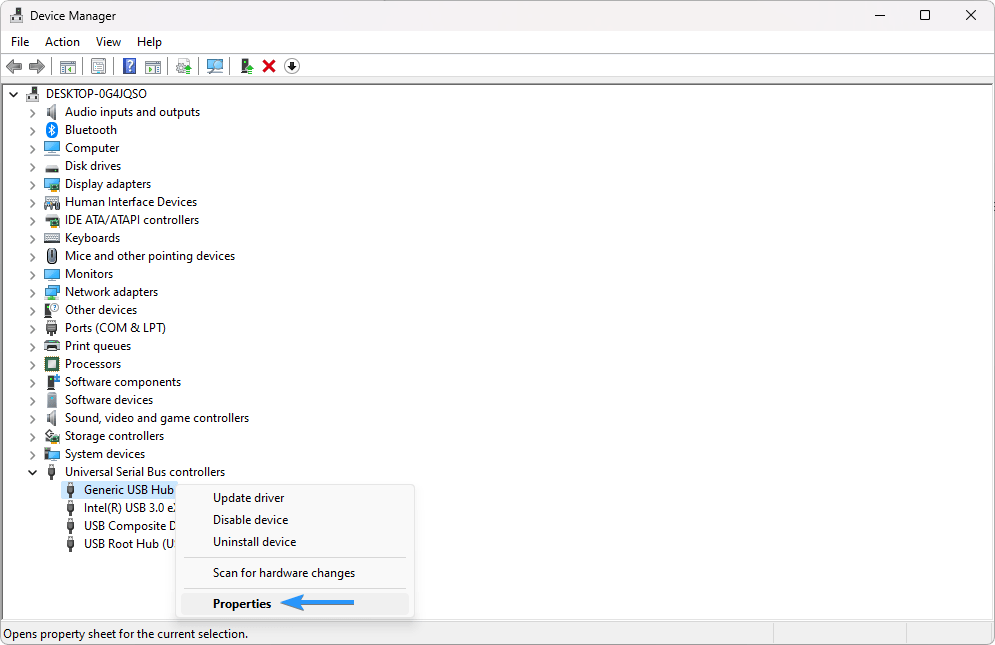
- Switch to the Power Management tab.
- Uncheck the box next to the “Allow the computer to turn off this device to save power” option.

- Click OK to apply the changes.
After disabling the power-saving feature, check to see if your USB ports are working properly. This step often resolves issues caused by power management settings.
7. Disable the “USB Selective Suspend Power Setting”
Disabling the “USB Selective Suspend Power Setting” can help resolve USB port issues caused by power-saving settings.
Steps to Disable USB Selective Suspend Power Setting:
- Type “Control Panel” into the search bar on your computer and open the first entry that appears.
- Navigate to Hardware and Sound > Power Options.
- Click on Change plan settings next to your current power plan, and then click the Change advanced power settings link.
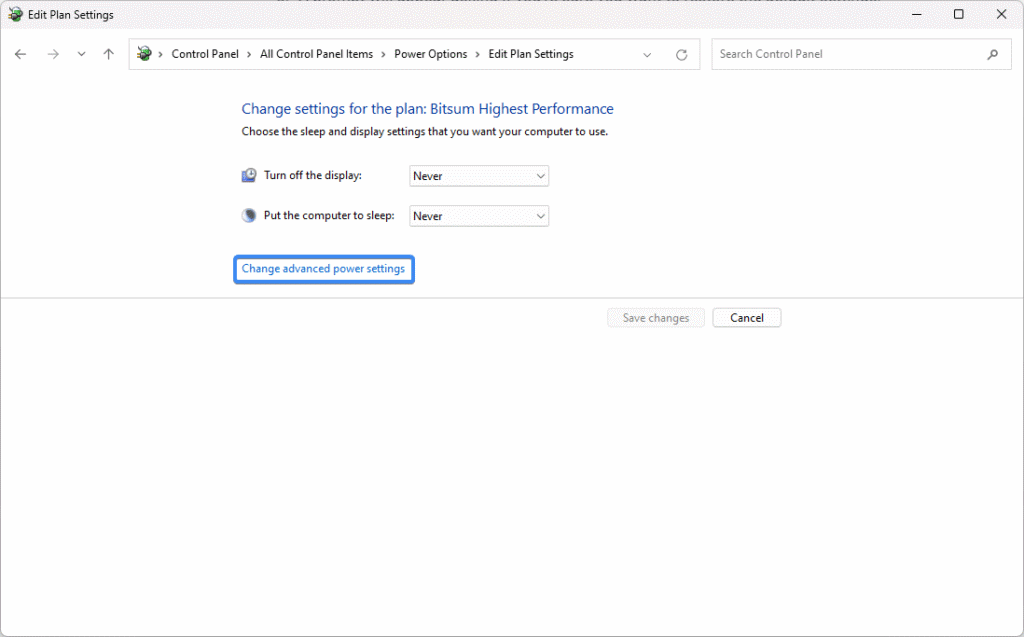
- A small window will appear. Locate the “USB settings” option. Click on the plus (+) icon next to it to expand the options.
- Expand the “USB selective suspend setting” by clicking the plus (+) icon again.
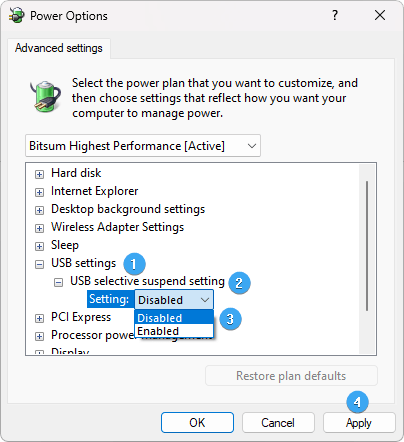
- Select “Disabled” from the drop-down menu.
- Click Apply, then close the window.
After disabling this setting, check if your USB ports are functioning correctly. This setting can sometimes cause issues, and disabling it can restore your USB functionality.
8. Run the SFC Scan
The SFC (System File Checker) scan checks your system files for corruption and can help repair any issues that may be affecting your USB ports functionality.
Steps to Run the SFC Scan:
- Open the search bar in your taskbar by clicking on the magnifying glass icon. You can also press Windows + S on your keyboard as a shortcut.
- Type Command Prompt in the search box. When you see it in the results, right-click on it and select Run as Administrator.
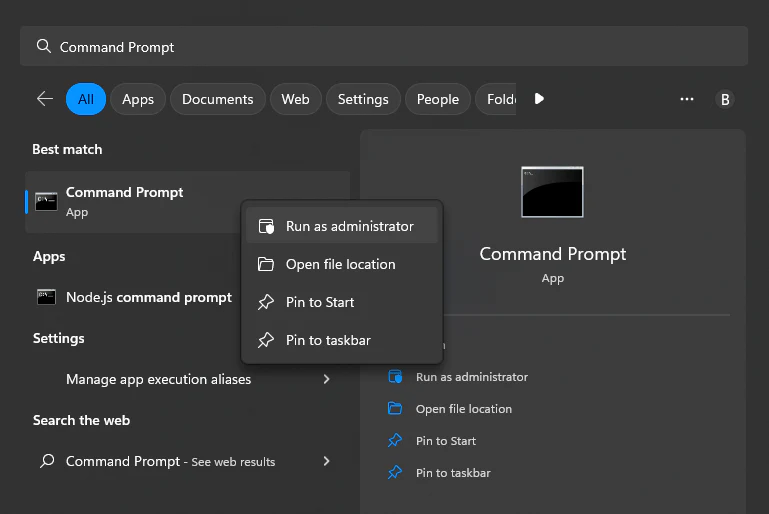
- When prompted by the User Account Control (UAC), click Yes to allow the app to launch with administrative permissions.
- Type the following command and press Enter to execute it:
sfc /scannow
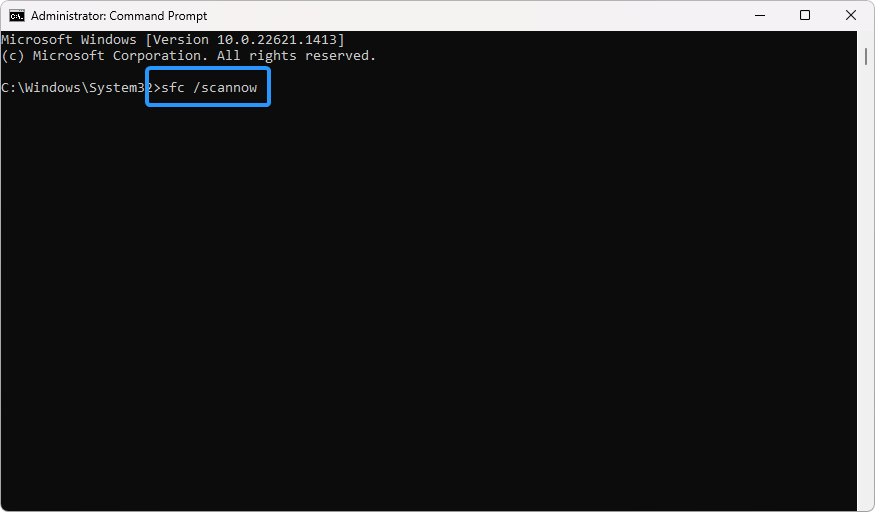
- Wait for the System File Checker to finish scanning your computer. If any issues are found, the utility will restore system files and fix any errors related to them.
Running this scan can help fix corrupted files that might be preventing your USB ports from working properly.
9. Run the DISM Scan
The DISM (Deployment Image Servicing and Management) scan checks and repairs system files for corruption. Running a DISM scan can help fix issues with USB ports functionality caused by corrupt system files.
Steps to Run the DISM Scan:
- Open the search bar in your taskbar (or press Windows + S) and then type in Command Prompt. When you see it in the results, right-click on it and choose Run as Administrator.
- When the User Account Control (UAC) prompt appears, click Yes to grant the app administrative privileges.
- Type the following command and press Enter to execute it:
DISM.exe /Online /Cleanup-image /Restorehealth
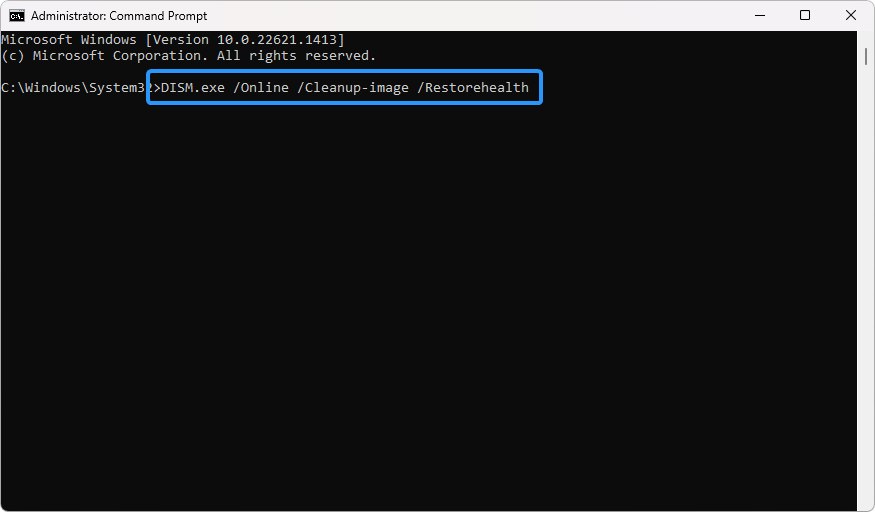
- Allow the DISM scan process to complete. After it finishes, close the Command Prompt and restart your device.
- Check if your USB ports are working properly after the restart.
Running the DISM scan helps repair system files and should resolve any USB port issues caused by corruption in your system files.
Conclusion
There are many potential causes of USB port issues in Windows 10/11. By following the solutions outlined above, you should be able to fix USB ports and get them working properly again. If the issue persists, it’s recommended to contact your computer manufacturer for further assistance.
We hope these steps have helped you resolve any issues with your USB ports in Windows 10/11. If you need further assistance or would like additional information, feel free to contact us, and one of our technicians will be happy to help you. Thank you for using our guide!
One more thing
If you’re in search of a software company that embodies integrity and upholds honest business practices, your quest ends here at Ecomkeys.com. As a Microsoft Certified Partner, we prioritize the trust and satisfaction of our customers. Our commitment to delivering reliable software products is unwavering, and our dedication to your experience extends far beyond the point of sale. At Ecomkeys.com, we provide a comprehensive 360-degree support system that accompanies you throughout your software journey. Your trust is our foundation, and we’re here to ensure that every interaction with us is a positive and trustworthy one.

